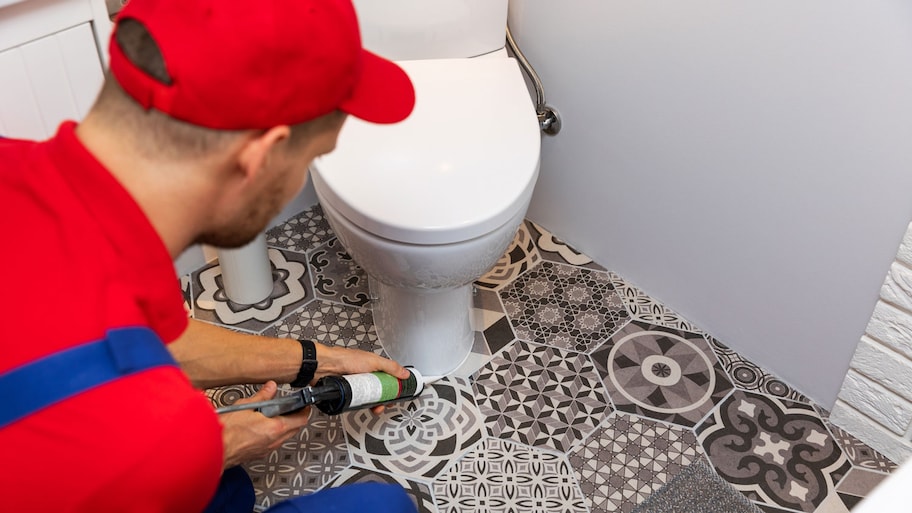Is Your Toilet Wobbly? Stop the Shake With These 3 DIY Solutions
Your trip to the bathroom shouldn’t feel like a trip to the amusement park


It’s true that your toilet contains several moving parts. One of those moving parts, though, shouldn’t be the toilet itself. A wobbly toilet is not only unsettling for its occupants—it can cause leaks and expensive damage to your home if left unchecked. Even if your toilet looks and feels secure, that creaking noise it makes when you sit on it may be cause for alarm.
There are three reasons your toilet may be making unusual noises. We’ll talk about them in order of severity and focus on wallet-friendly ways to repair each problem.
Why Is My Toilet Wobbly?
There may be several reasons you have a wobbly toilet. It may not actually be the entire toilet that’s wobbly, either; you may just have a loose seat that needs tightened or replaced. However, you could have worn-out caulking, loose or damaged bolts, or a toilet flange in serious need of some TLC. A wobbly toilet isn’t just a slight annoyance. If not fixed, it could lead to bigger structural issues with your entire system or pipes, which definitely isn’t what you want in the bathroom.
1. Fix the Toilet Seat
A loose seat or broken hinge may be the source of the noise. It won’t cause expensive problems, but it can be uncomfortable and possibly dangerous. Making a quick inspection will tell you what the problem is.
Tighten the Seat Hinges
It’s common for the seat fasteners to have simply loosened from the toilet bowl.
Access the hinge fasteners by prying open the fastener covers directly behind the lid on the top side of the hinges.
Insert a wide-blade regular screwdriver into the head of the fastener. You may also need to secure the nuts on the underside of the fastener with pliers.
Twist the screwdriver clockwise to tighten to hand-tight.
Replace a Broken Seat
Sometimes the seat hinges simply wear out and break. If the hinge fasteners are secured, but the seat still moves, you’ll have to replace the entire toilet seat.
2. Secure the Toilet
Closet bolts are the bolts located at the base of the toilet that appear to penetrate the ceramic and fasten to the floor. Before proceeding, check that the closet bolts and nuts are free of rust. If they’re significantly rusted, skip this step and go on to the next section.
Tighten the Closet Bolts
If your toilet is wobbling or rocking but you haven’t noticed any leaks, the nuts on top of the closet bolts may have simply become loose.
Using an open-ended wrench, gently tighten the nut on the closet bolt until it feels firm.
Use caution to not overtighten the nuts. This can cause the toilet to crack and require replacement.
Shim the Toilet
Your closet bolts may have become loose due to an unlevel flooring situation. This is a common issue with toilets installed over a tile floor. Filling voids between the bowl and the floor can eliminate the rocking toilet problem. Plastic toilet shims are available at hardware stores and home centers for just this reason.
Check for Leaks
Retightening bolts and shimming can be effective at stopping a wobbly or creaking toilet. However, if you move a toilet at all, the potential for leaks increases dramatically.
If it wasn’t leaking before, the repair may have caused a leaking situation and you’ll need to replace the wax ring or hire a plumber in your area to handle this task for you.
Flush the toilet 10 times or more, allowing the tank to completely refill between flushes.
Inspect the base of the toilet for any signs of water.
Inspect the ceiling of the floor below for leaks if the area is accessible.
Tip: To thoroughly check for leaks under your toilet, slide the edges of several dry paper towels under the base and flush several times. If any water shows up on a paper towel, it’s leaking.
3. Reset the Toilet Flange
If you’re still dealing with a rocking or creaking toilet after trying the above steps, it’s likely the flange under the toilet needs repair or replacement.
Remove the Toilet
To diagnose and repair the problem, you’ll need to uninstall the toilet. If you’re an intermediate DIYer who has plumbing experience, you can probably handle this task yourself. If not, hire a plumbing repair company near you to ensure everything goes smoothly.
Note: If water continues to come from the supply valve when you remove the hose, you’ll need to find your home’s main water valve and turn it off. Replace the defective supply valve before proceeding or call a plumber to assist.
Fix and Level the Floor
If water has been leaking under the toilet, the floor or subfloor may have been damaged. If this is the case, you’ll need to repair or replace damaged flooring before proceeding or call a local flooring company to help.
Repair Broken Toilet Flange
If your existing toilet flange is in good shape, but the closet bolt slots have failed, installing a repair flange is the easiest way to fix it.
Replace Broken Toilet Flange
The flange may have broken as a result of the toilet wobbling or creaking when you sit on it, or it may be the cause. If the existing flange contains cracks or has pieces broken from it, it’ll need to be replaced.
How to Prevent a Wobbly Toilet
Preventing a wobbly toilet in the first place is all about maintenance and vigilance. Check your toilet’s bolts ever so often for rust or damage, and tighten the bolts as needed before the wobbling gets out of control.
Additionally, you want to replace your toilet’s caulking every five years (or less if you start noticing a wobbling issue earlier). Caulking toilets is actually a requirement by the International Plumbing Code (IPC) Chapter 4 Section 405.6, so keep your toilet correctly caulked to avoid wobbling problems in the future.
DIY Wobbly Toilet Repair vs. Hiring a Pro

Performing your own toilet repairs yourself can save quite a bit of money. Tightening a toilet seat costs nothing at all if you do it yourself, while replacing a flange will cost under $50 for parts.
However, plumbing repair isn’t everyone’s favorite Saturday afternoon pastime. Plus, if you don’t have plumbing experience, you can end up making costly mistakes. It’s usually well worth your while to hire a local professional toilet repair pro to help you with your wobbly toilet problem.
Repairing or replacing a toilet flange costs $145 to $165 on average. Replacing a toilet costs $400 to $800 including labor, but just repairing a wobbly toilet may only cost $50 to $150. If you need to hire a handyperson service to repair water damage caused by a leaking toilet, be ready to pay an additional $150 to $350.
Xiao Faria daCunha contributed to this piece.
Frequently Asked Questions
Putting caulk around a toilet’s base where it touches the flooring can help hold the toilet in place. A more effective way is using caulk with plastic shim wedges. Place the shims underneath the base to steady and stabilize the toilet. Add some caulk to help keep the shims in place and provide a stronger and more lasting stabilization effect.
Recaulk your toilet at least every five years. If you feel like your toilet is getting wobbly before that, it still might be time for a new caulking. Never directly place new caulk over existing caulk because that doesn’t produce lasting results. Also, caulking over existing moldy caulk does not kill out the mold by suffocating it, so if you have mold, be sure to get rid of it before recaulking.
